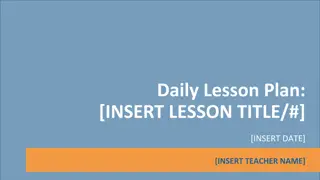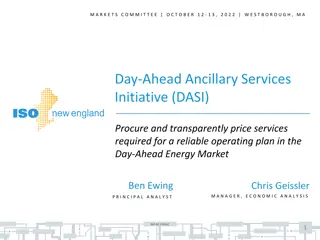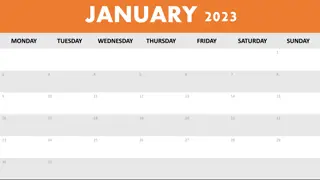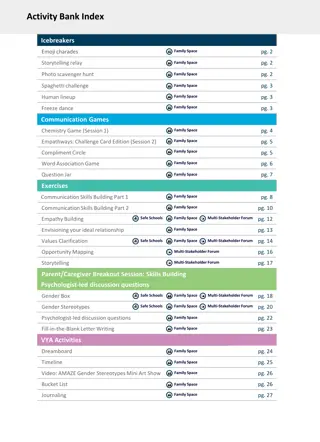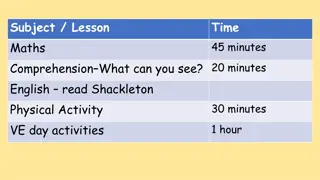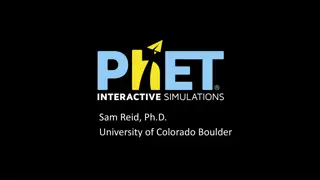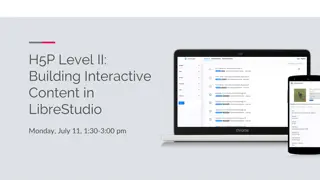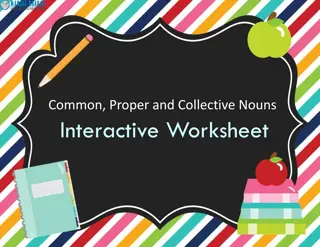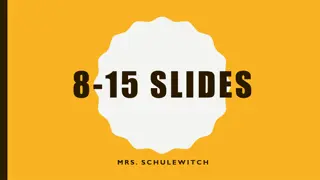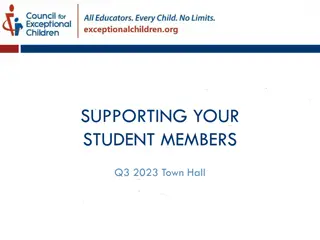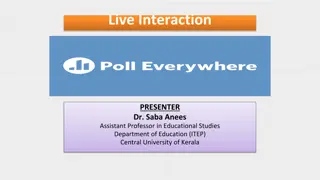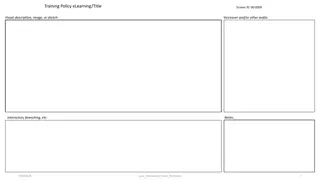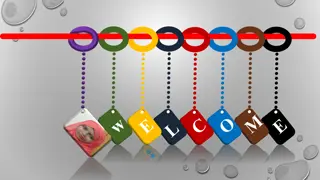Engaging First Day Interactive Activities for Student Understanding
Enhance your first class meetings by incorporating interactive activities that promote student engagement, communication, and a positive classroom environment. Utilize strategies to get to know your students, set clear objectives, and create a welcoming learning atmosphere from day one.
Download Presentation

Please find below an Image/Link to download the presentation.
The content on the website is provided AS IS for your information and personal use only. It may not be sold, licensed, or shared on other websites without obtaining consent from the author.If you encounter any issues during the download, it is possible that the publisher has removed the file from their server.
You are allowed to download the files provided on this website for personal or commercial use, subject to the condition that they are used lawfully. All files are the property of their respective owners.
The content on the website is provided AS IS for your information and personal use only. It may not be sold, licensed, or shared on other websites without obtaining consent from the author.
E N D
Presentation Transcript
First Day First Week Assessing Student Understanding Interactive Activity (Please note: This presentation is a combination of information from previous New Faculty Orientation Launching a Successful Semester strategy sharing sessions and from the Tech Center for Teaching and Learning.) 1
What is a typical example of a first class meeting? Essential Question to ask yourself What message(s) do I want to communicate to students on the first day(s) of class? Remember What if a tree falls in a forest, but nobody hears it. . . Like Dr. Watson said it s actually about Learning we can teach brilliantly all day long, but if the students don t learn, nobody heard the tree fall. 2
Research shows that: Students learn more when they actively discuss subjects in and out of the classroom (SGA President) And work together in small groups And in order for classroom climate to be established One which not only allows but promotes participation and discussion Current research and practice also indicate that it must begin the first day of class. Arthur W. Chickering and Zelda F. Gamson, Seven Principles of Good Practice in Undergraduate Education (The Wingspread Journal Special Insert, 1987) 3
You may want to: Plan for a substantive first meeting that addresses student needs and gives you useful information and insights Create a positive image of yourself and the classroom for arriving students Start class with an ice breaker Begin learning student names right away Take a picture of each student in class, or have them each email a picture to you (to help you learn names) Fill out a student information sheet Clarify your course objectives & expectations by reviewing syllabus & embellishing with useful detail Whet appetites for the course by sharing interesting and pertinent material Reassure students that the course is a wise investment of their time and resources. Complete an open ended evaluation at the end of class (more on that in a minute) 4
Name Game know your team members names by next Tues. Take up to six M&Ms (not too many of the same color) For each piece of M&M candy you took, you will say your name and answer a question, depending on its color. Red candy: favorite hobbies Green candy: favorite foods Yellow candy: If you had to trade places with someone, who would it be? Orange candy: area of emergency management that most interests you (tell of any emergency management experience you might have here) Brown candy: most memorable or embarrassing moments Blue candy: if you could have any talent what would it be?
Name Game know your team members names by next Tues. First person says his/her name Second person says first person s name, then says his/her own name. . . When it comes around again, first person has to say all the names and his/her own. Next: The person who was second in the last game is now the first person. Say your name and a word that is relevant to you (e.g. a sport, hobby, etc.). . .
What is the difference between the work life (age 25-64) earnings of someone with a bachelor s degree versus someone with just a high school diploma? Approximately $1,000,000. http://www.census.gov/prod/2002pubs/p23 -210.pdf
The beginning stage of a course includes the all-important first day and first week of class. During this formative period, it may be useful to view the process of building class community as the first topic that needs to be addressed in class. Allowing students early opportunity to interact with each other and with the instructor is a fundamental or foundational experience that should be covered before any other topic is introduced. Joe Cuseo, professor of psychology at Marymount College in Palos Verde, CA, who has contributed a great deal of scholarship to the field of the First-Year Experience. http://www.bgsu.edu/downloads/provost/file11002.pdf 8
To orchestrate positive first impressions. To introduce yourself effectively. To clarify the learning objectives and your expectations. To help students learn about each other. To get to know your students. To whet students appetites for the course content. 9
To teach your students to do well in the course. (McGlynn) To establish expectations with regard to student behavior. (McGlynn) To develop a community of learners in the class. (Cuseo) To avoid Millennials using their remote controls. (P. Gray) 10
At the end of class have students complete a One-Minute Paper evaluation by completing the following: I came expecting . . . I got. . . I am looking forward to. . . I am hoping. . . I could be helped by. . . Dr. Fleniken, past Director of the Tech Center for Teaching and Learning 12
As students conclude their first week in your class, it is wise to assess their perceptions in an anonymous, nonthreatening manner. Doing so helps you identify stumbling blocks before they can grow into large barriers later in the term, which lead to withdrawals, and most of all, reduce the success that students could otherwise achieve Invest two minutes to distribute paper or 3 x 5 index cards on which students may reply anonymously to several open-ended questions, such as: Who was the most interesting person you met in this class? Why? What things are you most looking forward to in this class? What concerns you about your ability to be successful in this class? What questions do you have that are not yet answered? What has surprised you the most about this class so far? http://ezinearticles.com/?Professors---Launch-Your-College-Course-Effectively- --Closing-Out-the-First-Class-Meeting&id=1709031 13
Analyze the information you collect from the student feedback Note any patterns among students feedback Reflect on the week as a whole and self-assess Identify actions you want to make as a result of the feedback Construct an email to each class member (small class), the class as a whole, or address at the beginning of the next week s class session. Continue to learn student names Create a profile of each student with information sheet, picture, and feedback evaluations 14
How will you maintain the momentum that you have generated with a successful beginning? Content assessment: End of each week (or topic), on a 3x5 (or bring in recycled paper from your ofc.) What can you tell me about ________(this is something you want them to know you will test them on it) What is the most interesting thing you learned this week? What questions do you have? Groups (white board option) Ask a key question or two and they answer on it, you walk around and comment on what they ve written. (e.g., list three reasons the Roman Empire fell? Or list three reasons everyone hates lawyers?) Pair them up and ask a question that they discuss, then you ask for feedback from the pairs 15
Each person at the table spends time individually writing/considering answers to the following question: What are some negative first day experiences you remember from when you were in college? How do you prevent the same experience? Members of each team discuss their answer with others at their table. Have a member from each team capture the answers on a flip chart in preparation for sharing with the overall group. (approximately 10 minutes) Have a member from each team summarize their findings for the overall group. (approximately 10 minutes) 16
Each person at the table spends time individually writing/considering answers to the following question: What do you do on the first day or during the first sessions that has/have been successful? What other techniques have you heard or read about that could be considered useful Is there anything you've always wanted to do on a first day but never done? What has kept you from doing it? Members of each team discuss their answers with others at their table. Have a member from each team capture the answers on a flip chart in preparation for sharing with the overall group. (approximately 10 minutes) Have a different member from each team summarize their findings for the overall group. (approximately 10 minutes) 17
Each person at the table spends time individually writing/considering answers to the following question: What is your definition of a successful first day, week and month? What are your goals for the first day, week, and month? Members of each team discuss their answers with others at their table. Have a member from each team capture the answers on a flip chart in preparation for sharing with the overall group. (approximately 10 minutes) Have a different member from each team summarize their findings for the overall group. (approximately 10 minutes) 18
Each person at the table spends time individually writing/considering answers to the following question: What questions do you have as you begin your teaching career at Arkansas Tech? Members of each team discuss their answers with others at their table. Have a member from each team capture the answers on a flip chart in preparation for sharing with the overall group. (approximately 10 minutes) Have a different member from each team summarize their findings for the overall group. (approximately 10 minutes) 19




